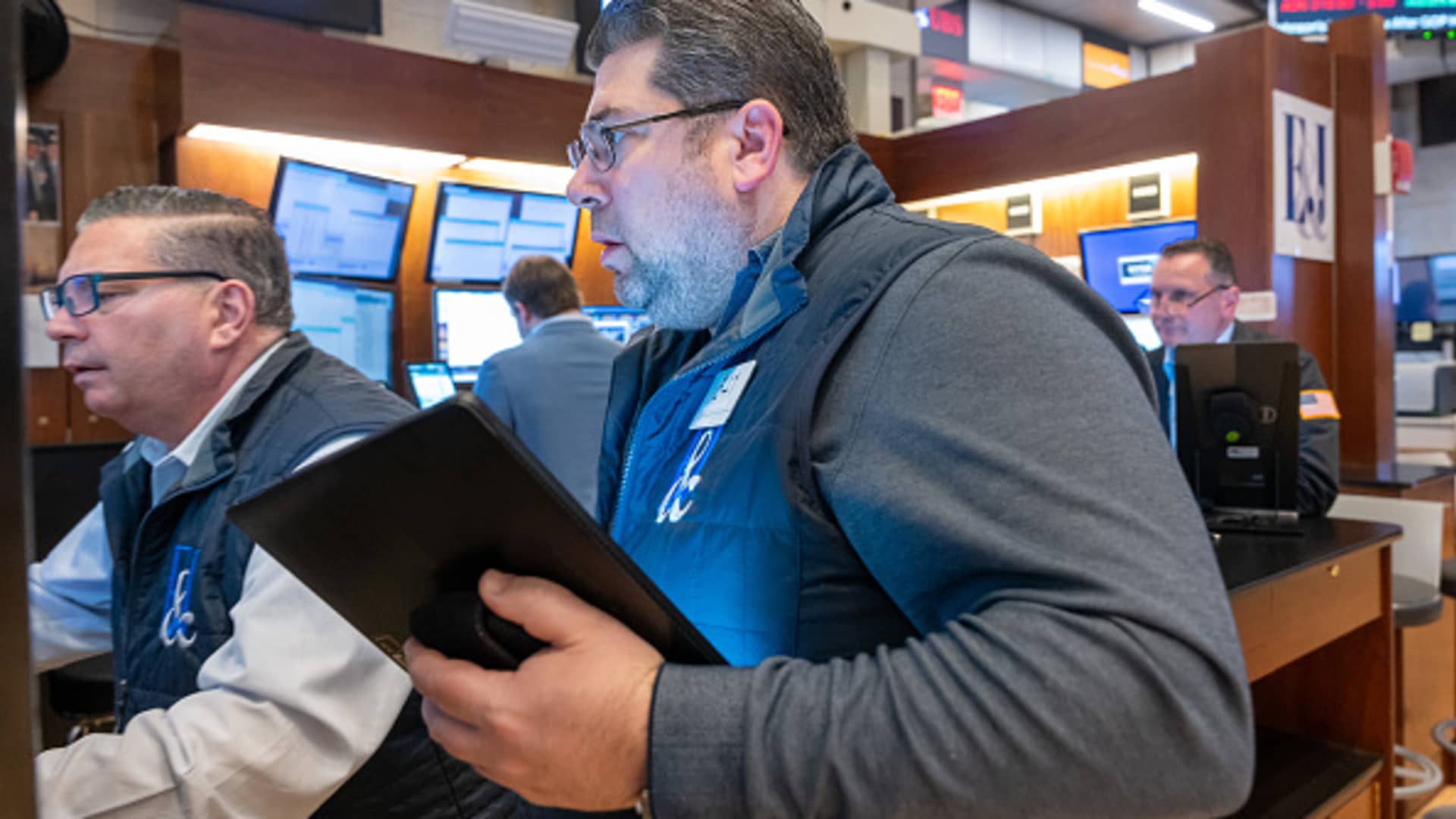From relentless rally to persistent pullback, five straight winning months without a 2% decline were then followed by three straight down weeks, featuring a rare six-day S & P 500 losing streak and five successive sessions last week of failed intraday rallies. As with all market retrenchments from a record high, the current 5.5% setback in the S & P 500 is accompanied by a litany of proximate causes, ready excuses and plausible cover stories — in addition to the simple “we were due” catch-all. The sticky-inflation and patient-Fed theme has carried the 10-year Treasury yield from 4.2% to above 4.6% in three weeks while expectations of a potential Federal Reserve rate cut have been shoved to the outer edge of traders’ time horizon. Typical seasonal headwinds starting in April of election years and after a strong first quarter apparently arrived on time. Hard-to-handicap geopolitical conflict never helps, even if it rarely serves as the key swing factor in a market trend. .SPX 1Y mountain S & P 500, 1-year And then there was simply the elevated valuation and over-optimistic sentiment that had built up over that five-month, 28% rally that culminated at the end of March. The dominant momentum leadership that broke stride a few weeks ago (and was previewed here as it peaked ) has continued to unwind, a self-reinforcing process in the short term. Friday’s treacherous rotation out of big-tech winners and into less-loved value sectors (semis down 4%, regional banks up 3%) was particularly stark and seemingly part of an ongoing reversal of extreme positioning among systematic trend-following strategies. We entered 2024 with a market whose most crowded stocks also happened to be some of the largest and most expensive in the world, granted a hefty premium for perceived predictability and the scarcity value of powerful secular-growth plays. Which takes us to the moment that’s featured in all pullbacks, when the question becomes whether the tape is stretched enough to the downside to expect at least a forceful rebound attempt. Bounce coming? Things are at least starting to line up in that direction. The Nasdaq Composite is doubled over in a grueling gut check, dropping nearly 8% from its recent high, cutting back below its old November 2021 peak, slicing below its 100-day average. In the process, it’s grown pretty oversold, with its 14-day relative strength reading (a measure of price relative to a longer-term trend) pretty close to levels seen in the vicinity of past trading lows. Some market-breadth readings (the low percentage of S & P 500 stocks above a 20-day average, say), elevated put-option volumes and the inversion of the Volatility Index (VIX) relative to VIX futures prices are all similarly hinting at a tightly coiled market susceptible to a high-velocity snapback attempt before long. This is where the caveats must be noted: Extremes can always grow more extreme and severe liquidation-type selloffs tend to start with oversold readings, with the ever-present chance that stressed trading mechanics among quantitative players can exacerbate pullbacks when they get into risk-reduction mode. Nothing works every time, nor are such oversold indicators always timely when they are prescient. Arguably the decline so far has been a touch too orderly, at least until Friday’s ferocious purge in semis. And while indicators of traders’ mood have shown increasing caution, most sentiment indicators are merely coming off excessive bullishness and not yet in outright fear mode. Over the long span of time, about 40% of all 5% market pullbacks deepened into full 10% corrections. According to Warren Pies, co-founder of 3Fourteen Research, after the Global Financial Crisis, “the 5% dip-buying odds…improved.” From 2009 through 2021, buying 5% dips was “a consistent winner.” On average, the market recovered to new highs within three months of any 5% dip and “only 35% of cases went on to become 10% corrections.” And yet, Pies stepped back from his previous bullish market view last Thursday, noting that the pattern may have shifted again since 2022, with the upward trend in Treasury yields helping to drive stock corrections rather than the former pattern of yields declining and acting as a buffer as stocks fell, leading most 5% drops to worsen into a 10% haircut. While observably true, it’s crucial to note that yields haven’t had to retrace all the way back to their levels from before the equity correction in order for stocks to get relief. They have simply needed to stop rising and settle back somewhat. Remember, since 2022, stock investors have successively fretted that 3%, 3.5%, 4% and now perhaps 4.6% 10-year Treasury yields would be kryptonite to stocks. Yet under the right conditions, once the economy shows it can absorb such yields, equities have been able to make a tentative peace with them. A 10%-ish correction from the S & P 500 high of 5254 would pull the index down below 4800, the former record high from early 2022, and so would be a test of the first-quarter breakout. (In 2013, after the S & P 500 had made its first record high in over five years, it doubled back to briefly test the former record level within a few months before resuming its advance.) It’s useful to keep in mind that when stocks go down in price they also go back in time, returning to some prior point against which we can assess current fundamentals and ask whether anything substantive has changed. A week ago, I noted the S & P had closed at the exact level from March 8 – the moment of peak “We can have it all” sentiment, with Fed Chair Jerome Powell implying rate cuts soon on the 7 th and a just-strong-enough jobs report that day underscoring economic resilience, and with an AI-stock buying crescendo as a sweetener. Last week’s 3% decline took the index back to Feb 21 and thereby closed the “Nvidia gap,” the 100-point S & P 500 pop the day after Nvidia’s blowout fourth-quarter earnings report. Nvidia shares themselves closed just above its Feb. 22 level, though are a couple of P/E points lower (29-times forward earnings now versus 31.5 then) thanks to rising profit forecasts. Valuation check As for the broader market, the S & P 500’s forward multiple is down from 21 a month ago to 20, no one’s definition of cheap, though as ever the equal-weighted index sits at a glaring discount to the marquee version. Betting on the wider field of stocks to do well relative to the dominant trillion-dollar-and-up market-cap has been tricky due in part to those rising bond yields, which in recent times have smothered any broadening action. Not only are cash-rich, secular-growth mega-caps inured to higher financing costs, they are deemed generally defensive against macro flux. Not to mention the fact that Big Tech dominates the earnings-momentum scoreboard, with significant upward profit revisions in recent quarters. With Treasury yields taking a breather on Friday from their recent project of probing for the economy’s pain threshold, energy and traditional defensive groups were the main leaders, along with financials. Whether this reflects healthy rotation in response to economic resilience or more the erratic flight from crowded bets by fast professional players is a question to hold in mind into next week. Regional banks, up 3% Friday, are now four quarters removed from the mini-crisis around Silicon Valley Bank, with credit and deposit pressures looking manageable for now, and the stocks as a group trading at just 90% of book value in what most are now arguing is a briskly growing economy. Next week brings the PCE report which will mark inflation to market relative to the Fed’s target, leaving open the prospect of another narrative shift in a less-hawkish direction now that the market has migrated to assumptions of an indomitable consumer and a higher-for-longer rate assumption. On a trading basis, aside from the oversold readings starting to accumulate, it would seem the pullback has helped at least to clean up aggressive positioning and cool off investor expectations just in time for the heaviest week of big-cap earnings reports. Read More
Breaking down the market sell-off and odds this 5% pullback turns into a 10% correction
2024-04-20T12:03:36-04:00April 20th, 2024|




